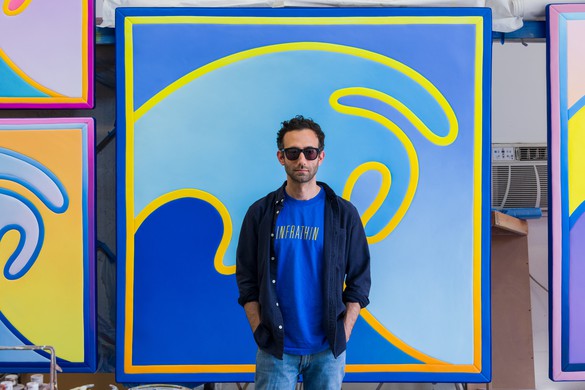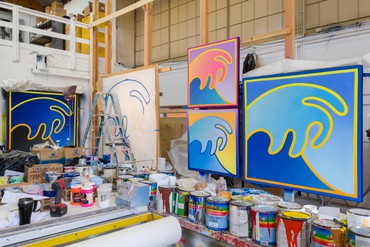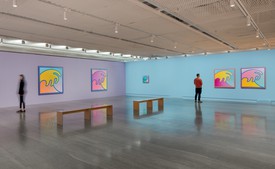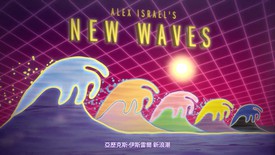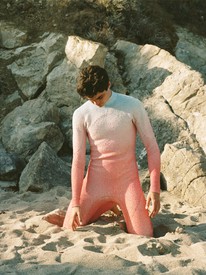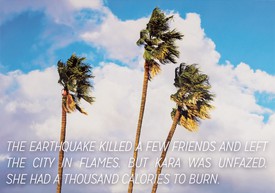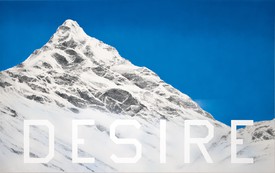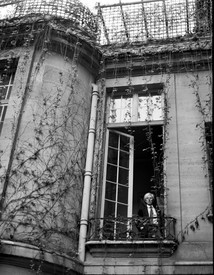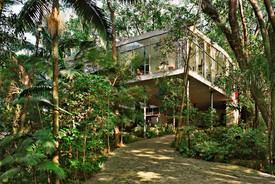Venus LauThe neon-noir trailer of New Waves—your first Hong Kong solo exhibition—interweaves Hong Kong skylines with Southern California symbols, such as highways lined with palm trees. It is a prelude to the connection between two cities with very different coastal cultures. As an artist whose practice is closely tied with LA culture, how do you suture the cultural contexts from these two metropolises through this show?
Alex IsraelWaves seemed like the most natural subject to suture the contexts of LA and Hong Kong—after all, they share the Pacific Ocean between them. I appreciate that you used the word “suture,” because actual stitching played a big role in the making of my Waves. Neoprene fabric—which we stitched together and pulled over stretcher bars, molded, cast in resin, and finally painted—is at the root of these works.
VLYour fashion line, Infrathin, whose name is inspired by the titular concept by Marcel Duchamp, feels like a “3.0 version” of your sun eyewear project Freeway (inspired by the highway system in Los Angeles). Why do you reference this Dadaist idea concerning a membrane-like, ineffable in-between-ness to your practice?
AII would say clothing, as opposed to fashion, but yes—Infrathin evolved out of Freeway and my wanting to design and produce a wider array of branded merchandise. Duchamp, for me, is patron saint. I’m always learning from and finding inspiration in his work, and it just seemed natural to use his word, Infrathin, in naming the line. I often think about the infrathin—the aura of art, the difference between art and life. Making non-art, or making things that are in-between or art-adjacent can be incredibly freeing and inspiring. In my experience, that freedom and inspiration often pours over into the next body of work.
VLCan you tell me more about SPF-18, a film you co-wrote with Michael Berk, focusing on a teenage audience?
AII wanted to make something for a younger audience, and make it available to them through the channels which they already comb for content: their high schools—we did multiple screenings at high schools across America—and online.
VLSPF-18 is available on Netflix, and your clothing items are sold online and offline (for example, at Dover Street Market). This demonstrates a process of translating the symbolic/art values to market values seeping outside the gallery walls. You have mentioned Rotoreliefs presented by Marcel Duchamp in Concours Lépine, 1935, when we talked about this dynamic. Can you elaborate?
AIDuchamp’s experience with the Rotoreliefs seemed to stem from his searching for a new context and audience for his work.
I love making art and working within the art world, but I also love meeting new people and learning new things. Sometimes, rather than deciding which context to address with a specific body of work or project, I just think of myself as my context…and that’s sort of where my Self-Portrait comes into play. It has become a kind of logo for this imagined context of me—and it hopefully provides a through-line as my work shifts or twists across traditionally segregated worlds or value systems.
VLThere is a flying pelican in the exhibition. How does the pelican contribute to the narratives of the exhibition in Hong Kong?
AIThe pelican is my spirit animal. I had this revelation back when we were shooting SPF-18. California brown pelicans fly up the Malibu coastline along the waves, and occasionally break off and circle above the shore to look for fish in the water below. During our shoot, oftentimes, they’d enter our camera’s frame. In the animated short video I made for this show, the pelican finds his fish, a koi or Poisson Japonais, which is actually taken from the design of one of Duchamp’s Rotoreliefs. The pelican eating the fish sets off a chain reaction—a ripple grows into a swell of waves, which heads east across the Pacific to Hong Kong. At the end of the video, the reveal is that I’m actually inside the bird’s eye, piloting the pelican-shaped spacecraft. I flash a peace sign.
VLWhen talking about Waves, you brought up two cultural references: the colorful, blob-like sculptures and works on paper by Ken Price and The Great Wave off Kanagawa (this woodblock print from the Edo period has become a modern “meme” about the East) from Katsushika Hokusai’s Ukiyo-e series The Thirty-Six Views from Mount Fuji. They both have a hand-like structure (Hokusai’s waves look like eagle-claws in this work, compared to the softer ones in his early practice). How did you develop these images into the almost cartoonist images of waves in your recent works?
AII first sketched the wave as a directive for the animators I worked with on my film. In the dream sequence, the wave is source of both fear and inspiration for Johnny, the young male lead. Hopefully its hand or claw-like shape, inspired by the work of Price and Hokusai, helps it pull off this double-edged symbolism. When it came time to translating the image into an object, neoprene was a natural starting point not just because of the connection to surfing and the fact that wetsuits are supposed to fit like a glove on a hand. But also because neoprene’s skin-like qualities further the anthropomorphic qualities of the work—even though they’re solid and hard, the Waves appear soft, squishy and skin-like. They’re hollow and have imperfect lines and edges—like our bodies. I love that the viewer might relate to them in a physical way, body to surrogate-body.
VLSPF-18 suggests the idea of skin (via sunscreen) and in your Flat paintings you applied a stucco-like texture, which is part of LA’s urban fabric. What part does the idea of epidermis play in your portraying of LA culture as a whole corpus?
AISkin or surface, from stucco to sunscreen, has been a constant theme in my work. I’m sure that’s in part due to my growing up here in LA. This is a city of skins, and I’m devoted to the history and meaning of where I am from. On another note, someone once said, “I’d rather be deeply superficial than superficially deep.” I’ve always related to that.
Alex Israel: New Waves, Gagosien Hong Kong, May 24–August 11, 2018
